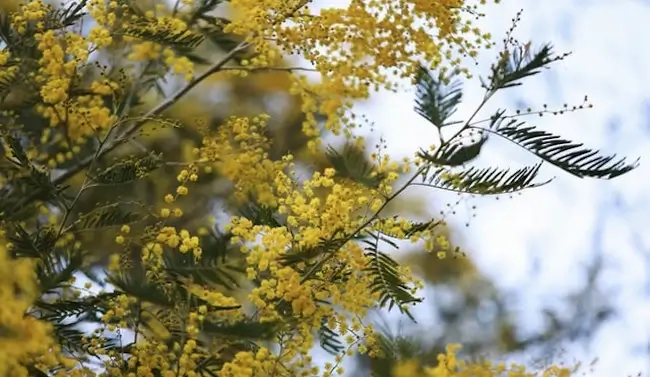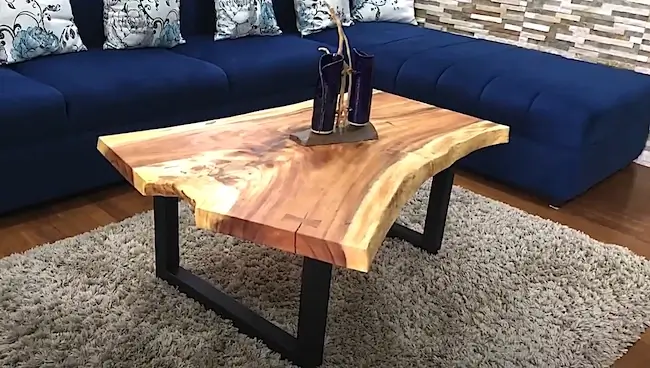
Whether you’re an expert in interior design or a DIY enthusiast, you’ve likely come across acacia wood. This remarkable type of woodworking wood was famously mentioned in the Bible! Namely, the Ark of the Covenant and the Tabernacle were both built from acacia wood. It’s so durable that it could survive the biblical apocalypse.
Nowadays, acacia wood is one of the best for almost everything from outdoor furniture wood products to flooring, and it also has decorative uses. Also, it is on the top 10 list of most expensive woods globally. So, what’s so special about acacia wood?

Find out what makes acacia wood one of the most popular types of wood in the world:
“The uniqueness of Acacia wood lies in its impressive durability and high resistance to water, making it an exceptional choice for crafting sturdy furniture and structures. Moreover, with its rich, stunning hues and grains, this wood is not just a material, but an embodiment of nature’s artistry.”
Dr. Zephyr Graham, Forestry Ph.D.
Acacia wood profile and facts
First, let’s see how acacia wood performs on the famous Janka scale. Even though it’s naturally smooth, this wood has a Janka hardness rating of 2300 pounds of force. That means it’s a wood 55% more rigid than European white oak, 23% more than hickory, and finally, 90% than carbonized bamboo wood.
Acacia wood is famous for its grain patterns, straight or wavy. This wood has all-natural shades, from white oak to deep brown like mahogany. Its versatility in appearance makes it a popular choice when deciding between different hardwood floors
The acacia wood is on the scale of hickory and black locust in terms of hardness. It’s harder than walnut but not as hard as osage orange. In terms of color, it varies from white acacia wood, like birch, and ranges close to reddish-brown.
Acacia is a type of wood original from Africa. It is know for its high durability which makes it a great option for furniture. Acacia is very resistant to water and exposure, it is also very manageable.
Acacia furniture
Acacia wood is the queen of natural furniture, adding a bit of luxury.
The species of acacia we use for furniture is called Babul acacia, and this tree was initially found in Africa. The pros of this hardwood are that it’s resistant to decay, robust, and easy to manipulate.

Tips for acacia wood furniture
If you have acacia furniture, for the best care following these tips:
Acacia flooring
Acacia makes durable floors. Apart from cheering up the room with the warmness of the colors, the acacia flooring is easy to care for.
To take care of this type of wood properly, it’s better to buy an oil-based floor cleaner, warm water (around 30°C) and you should dry it up as soon as possible to prevent moisture absorption.
Tips for acacia wood furniture
To care for acacia floors, the less you do, the better. Here are some tips for maintaining that gorgeous natural shine and texture for the next 50 years:
What is so special about acacia wood?
Indeed, acacia is a beautiful natural wood. But, it’s special because of the durability, visual appeal of the patterns, and water-resistant properties. These characteristics make it a strong contender when comparing hardwood vs. laminate flooring options.
The most notable thing about acacia wood is its versatility in use.
On the one hand, it’s resistant to scratching, just like other hardwoods, such as oak and teak wood. For building furniture, that is essential.
Acacia wood has found its place in everything, from making bowls to ships for the navy. You can see a thousand different variants, from the durable Babul acacia used in the furniture industry to Acacia koa for ukuleles in Hawaii. Its versatility rivals that of other popular woods like ash and oak.
Acacia is also protected from any insect attack, thanks to its natural alkaloids, so you can peacefully place furniture outside.
Is acacia wood real wood?
Yes, in the sense that it’s natural, efficient, and affordably produced from the acacia tree.
Acacia tree
The Acacia tree is highly durable and has grain patterns. That’s all common for the acacia genus.
Acacia tree, or Mimosa, was native to Australia, but it spread out to Africa. Soon it conquered the whole world. You see, the acacia tree thrives in various climates. That makes it sustainable and eco-friendly since manufacturing costs are low.
What’s also fascinating about the Acacia tree is that it stores harmful carbon emissions, lowering the greenhouse gases effect. In addition, acacia trees produce water-soluble gums, so it’s popular in the food industry.
Have you heard of the false acacia tree? It has the leaves of natural acacia, but it’s the Black locust.
Is acacia an expensive wood?
Yes, it is. It’s in the top 10 most costly kinds of wood globally, mainly because of its durability.
There is a unique acacia species called Australian Blackwood. Despite being an invasive species, this wood is costly and luxurious. It’s cheaper than Koa.
Acacia wood is in the mid-range since it’s not widespread as oak. However, it’s cheaper compared to teak wood for flooring. But, teak wood can go for longer with no maintenance, so you have to keep that in mind when browsing these types of wood.
The Acacia price starts at $7 per square foot, it can get more expensive depending on the area where you live and the conditions of the wood piece.
Whether you want to make furniture or kitchenware, it’s the perfect material considering the prices of natural hardwood. Meaning you get the best bang for your buck when you build benches, countertops, and cutting boards from acacia wood.
Is acacia wood a hard wood or soft wood?
Acacia wood belongs to the hardwood type. That means that the Acacia trees are slow-growing, producing denser wood than oak and maple. The Janka hardness rating is 2300 pounds of force, making it versatile.
Acacia wood found its use in anything from outdoor furniture to interior design. So, you can even make support beams from it because of the insane durability in addition to the fire resistance.
The hardest of all acacia woods in the world would be the Raspberry jam acacia, reaching 3,100 on the Janka scale. You might have heard that carpenters love this acacia!
Acacia products are fantastic for decoration
We hope that we have helped you find out precisely what acacia wood is, why it’s such an expensive natural hardwood, and how to care for it if you have acacia furniture and acacia flooring. You also know how this beautiful wood compares to other wood, such as teak wood.
Let us know in the comments if our tips helped you care for your acacia wood!





My affinity for acacia wood began while visiting a plywood mill on a whim in Australia, stumbling upon the lustrous rich texture of acacia timber. The sample’s durability under my incessant whittling left quite an impression. However, procuring good quality acacia timber in Oregon has proven quite the challenge.
Good day, Juniper! As someone who has been working with different types of wood for years, I can attest to your struggle. When acquiring acacia wood here in the States, it’s crucial to establish relationships with reputable timber suppliers, it can make a world of difference. For high-quality acacia timber, you might want to consider reaching out to suppliers who directly import their timber from Australia; they often carry the most durable variations.
I couldn’t agree more, Leonidas. In my years of experience, I found that suppliers who import acacia directly from Australia do indeed carry the highest quality and variety. Additionally, these suppliers generally have direct contact with sustainable harvesters which ensures that our purchases contribute to responsible forestry practices.
Hi Fabiana Quintessa, I also concur that the quality of acacia varies greatly based on where it’s imported from. During my years teaching woodworking, we once had a batch of acacia that was not as durable as we expected because the supplier switched their import source. Students’ projects were coming apart soon after completion, forcing us to change suppliers promptly.
Norris Rothman, your experience definitely resonates with me. During my tenure as a carpentry instructor, I also had similar encounters where the inconsistency in acacia wood quality led to varying durability in the finished products.
In my years of working as an interior designer, I’ve seen firsthand how diverse acacia wood can be in terms of quality and durability. While it’s considerably more robust than many other wood types, I have noticed some inconsistencies depending on the source and quality checks. As professionals in this sphere, we must do our due diligence when sourcing these kinds of materials. It does well to remember that even the best types of wood can vary greatly in quality due to a multitude of factors like origin, storage, and processing methods.